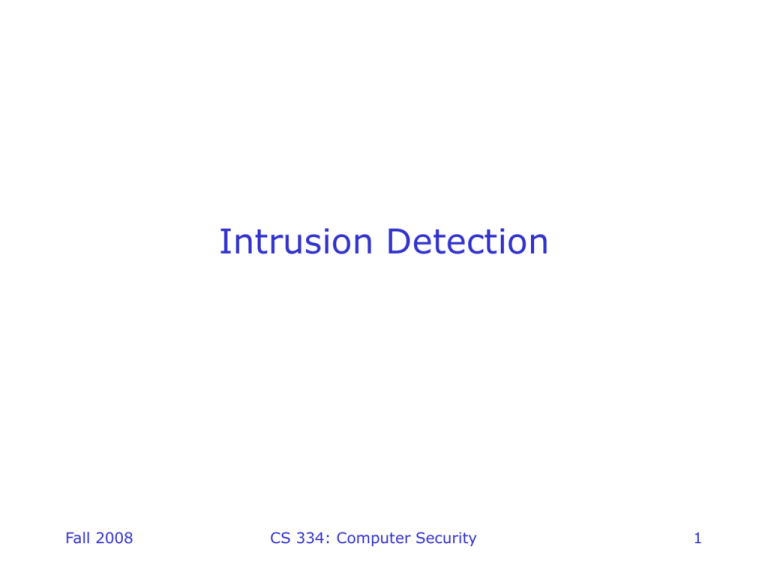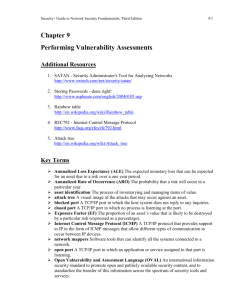IntrusionDetection
advertisement

Intrusion Detection Fall 2008 CS 334: Computer Security 1 Thanks… • To Anthony Joseph, Doug Tygar, Umesh Vazirani, and David Wagner for generously allowing me to use their slides as the basis for this set of slides. Fall 2008 CS 334: Computer Security 2 Outline • History • Network-based Host Compromise • Host-based Network Intrusion Detection – Signature-based – Anomaly-based • Distributed Network Intrusion Detection – Honeypots – Tarpits • An attack against an IDS Fall 2008 CS 334: Computer Security 3 Intrusion Detection History • Detecting attempts to penetrate our systems – Used for post-mortem activities – Related problem of extrusion (info leaking out) • In pre-network days (centralized mainframes)… – Primary concern is abuse and insider information access/theft – Reliance on logging and audit trails • But, highly labor intensive to analyze logs – What is abnormal activity? – Ex: IRS employees snooping records – Ex: Moonlighting police officers Fall 2008 CS 334: Computer Security 4 Network-based Host Compromises • How do remote intruders gain access? • They attempt network-based attacks that exploit OS & app bugs – Ex: Denial of service, spyware install, zombie,… Fall 2008 CS 334: Computer Security 5 Host-based Network Intrusion Detection • At each host, monitor all incoming and outgoing network traffic – for each packet: – Analyze 4-tuple and protocol – Examine contents – … • Challenge: Separate “signal” from “noise” – Signal is an attack (intrusion) – Noise is normal “background” traffic – Assumption: can separate signal and noise… Fall 2008 CS 334: Computer Security 6 Some Challenges • What is normal traffic? – Server, desktop, PDA, PDA/phone, … – My normal traffic? Your normal traffic? • What if I’m hurt and work from home for a while? – Lots of data for servers • Why do we need sufficient signal and noise separation? – To avoid too many false alarms! • What happens if signals are missed? – Possible intrusion! Fall 2008 CS 334: Computer Security 7 Some Common False Positives • Proximity probes – Website load balancers will probe your machine for proximity – Connect to website hosted by mirror-image.com, and >10 load balancers in 6 countries probe your machine • Stale IP caches – Using dynamic IP addresses, you may get the “old” address of someone who was running a P2P app – Peers continue to try to “re-connect” • Web posts with dynamic IP addresses – Spiders crawl machine currently using IP address Fall 2008 CS 334: Computer Security 8 Lots and Lots of Data!! • Network trace from Win2K desktop Fall 2008 CS 334: Computer Security 9 Trace Analysis Fall 2008 CS 334: Computer Security 10 Analyzing Host-based Trace Data • TCP connection probes on port 445 • Day 0 is March 4, 2003 Fall 2008 CS 334: Computer Security 11 Some Background: MS Blaster • Worm affected Win XP and Win 2K, began spreading August 13, 2003 • Programmed to “SYN flood” port 80 of windowsupdate.com on August 15, thus creating a DDoS attack • Exploited buffer overflow vulnerability (no surprise there) in Microsoft’s DCOM RPC service (located at port 135) – DCOM (Distributed Component Object Model) is proprietary MS technology for communicating among software components distributed throughout network Fall 2008 CS 334: Computer Security 12 Some Background: MS Blaster • Port 445: reserved for MS Directory services. • MS silently installed Internet server into every version of Win 2K, accessible via port 445 • Allows crackers to remotely log on to computers, then upload and run any program without computer owner being aware • One method for setting up a “Botnet” • In addition to port 135, Blaster also targeted ports 139 and 445 • Blaster propagated by testing connections to random IP addresses using these ports Fall 2008 CS 334: Computer Security 13 MSBlaster in Detail • TCP 445 probes/hr • Hour 0 is on July 20, 2003 (hours) Fall 2008 CS 334: Computer Security 14 MSBlaster in More Detail • TCP 445 probes / 10 min • Minute 0 is 15:20 on July 20, 2003 Fall 2008 (minutes) CS 334: Computer Security 15 Example Common Attack • Port scanning a host – Trying to connect/send data to different ports/protocols: sequential scan of host – Nmap tool (http://www.insecure.org/nmap/) • Determines OS/hostname/device type detection via service fingerprinting (ex: SGI IRIX has svc on TCP port 1) • Determines what svc is really listening on a port and can even determine app name and version • Operates in optional obfuscation mode • How to detect attack? Fall 2008 CS 334: Computer Security 16 Intrusion Detection Using Signals • This is a misuse detection problem – Similar problem to virus detection – “Match what you know” • High-level solution: – Collect info about attack methods and types • 4-tuple/protocol • Packet contents – Create and look for signatures • Slammer packet, port scan, … Fall 2008 CS 334: Computer Security 17 Intrusion Detection Using Noise • This is an anomaly detection problem – Need to learn normal behavior – “Match what’s different” • High-level solution: – Try to identify what is normal traffic • Common 4-tuple/protocol – Heuristic: Look for major deviations (outliers) • Ex: unusual target port, source addr, or port sequence (scan) – Apply AI: Statistical Learning Techniques Fall 2008 CS 334: Computer Security 18 Signature Detection • Language to specify intrusion patterns – 4-tuple/protocol and potential intrusion values • Ex: External host -> file server (port 110, 135, …) • Ex: Internal workstation -> external P2P host – Packet contents • Could be single or multiple packets (stream reconstruction) – Sequence of 4-tuple/protocol and packets • Also, model of protocol/app finite state machine • Lots of state in pattern matching engine • Example rule: – alert tcp any -> my ip 21 (content:"site exec”; content:"%"; msg:"site exec buffer overflow attempt";) Fall 2008 CS 334: Computer Security 19 Signature Detection • Snort tool (http://www.snort.org/) – 2 million downloads, 100,000+ active users, • Advantages – Very low false positive (alarm) rate • Disadvantages – Only able to detect already known attacks – Simple changes to attack can defeat detection • Ex: Scan every even port, then every odd port… Fall 2008 CS 334: Computer Security 20 Anomaly Detection • Analyze normal operation (behavior), look for anomalies – Uses AI techniques: Statistical Learning Techniques – Compute statistical properties of “features” • 4-tuple, protocol, packet contents, packets/sec, range of port numbers, … – Report errors if statistics are outside of “normal” range Fall 2008 CS 334: Computer Security 21 Anomaly Detection • Advantages – Can recognize “evolved” and new attacks • Disadvantages – – – – – – High false positive rate (alarms) May have delayed alarm Some attacks can hide in “normal” traffic SLT requires training on known good data Hard to capture protocol state behavior (FSM) Problems when what’s “normal” changes • Ex: flash crowds Fall 2008 CS 334: Computer Security 22 Super Stealthy Port Scanning • Use many zombies (each scans a few ports/hour of target) – Each zombie is assigned many machines to scan • Fast to scan both one machine, and many • Very hard to detect at targets! Fall 2008 CS 334: Computer Security 23 Distributed Intrusion Detection • Place appliance in the network at choke point or, share results across machines • Apply signature or anomaly detection across larger data set • Advantages: – Easier to detect stealth probes of large number of machines • Disadvantages: – Large amount of data to communicate Fall 2008 CS 334: Computer Security 24 Honeypots • Closely monitored network decoys • May distract adversaries from more valuable machines on a network • May provide early warning about new attack and exploitation trends – Enables in-depth examination of adversaries during and after exploitation Fall 2008 CS 334: Computer Security 25 Honeypots • Can simulate one or more network services on one or more machines – Can have virtual cluster of machines • Causes an attacker to think you're running vulnerable services that can be used to break into the machine – Can log access attempts to those ports, including the attacker's source IP and keystrokes – Can watch attacker in real-time and trace back/forward • Provides advanced warning of an attack – Could use to automate generation of new firewall rules Fall 2008 CS 334: Computer Security 26 Tarpits • A very,very sticky honeypot… • Set up network decoy – For each port we want to “tarpit,” we allow connections to come in, but don’t let them out • Idea: – Slow down scanning tools/worms to kill their performance/propagation because they rely on quick turnarounds – Might also give us time to protect real hosts Fall 2008 CS 334: Computer Security 27 Example Tarpit Implementations • Accept any incoming TCP connection • When data transfer begins to occur, set TCP window size to zero, so no data can be transferred within the session • Hold the connection open, and ignore any requests by remote side to close session • Attacker must wait for the connection to timeout in order to disconnect Fall 2008 CS 334: Computer Security 28 Tarpits • Advantages – Can customize for specific worms • Ex: analyze incoming packets to port 80 and only tarpit web connections from worms – look for “cmd.exe” (CodeRed) or “default.ida” (Nimda) • Disadvantages – Might trap valid host – Can cause some operating systems to crash Fall 2008 CS 334: Computer Security 29 Intrusion Prevention Systems • We can detect intrusions, so why not automatically cut off network connections to compromised hosts? • Intrusion Prevention Systems do this • But, what if we’re wrong… – Possible Denial of Service – trick IPS into thinking host is compromised – Turn off access our airline reservation server when a fare deal causes very high/different traffic patterns Fall 2008 CS 334: Computer Security 30 Witty Worm (March 2004): Attacking the IDS • Targeted a buffer overflow vulnerability in several of Internet Security Systems IDS products • Deletes a randomly chosen sectors of hard drives over time killing system • Payload contained phrase: – “(^.^) insert witty message here (^.^)” – Thus the name of the worm • First worm to take advantage of vulnerabilities in software designed specifically to enhance network security Fall 2008 CS 334: Computer Security 31 More Witty Firsts • First widely propagated Internet worm with a destructive payload • First worm with order of magnitude larger hit list than any previous worm • Shortest known interval between vulnerability disclosure and worm release – 1 day • First to spread through nodes doing something proactive to secure their computers / networks • Spread through a population almost an order of magnitude smaller than that of previous worms Fall 2008 CS 334: Computer Security 32 Intrusion Detection Systems Summary • On going arms race between attackers and detection technologies • Real challenge is false positive rate – Renders most IDS useless – alerts ignored • Adaptive, anomaly detection is promising, but still lacking • IPS products are still immature and problematic • IDS products are now targets Fall 2008 CS 334: Computer Security 33







